LTE: How does it really work that everything is ready?

Before LTE questions asked a lot. Today remains the most important: when ? When will this happiness come to us, to Russia? A month ago, I did not know what to say to people. Strongly complexed about this, because so close to the topic. Doubt whether the end of 2012, or the beginning of 2013. No certainty! But now, after the historic decision of the State Committee for Human Rights on September 8 , everything finally became clear.
I am sloppy, what is LTE?
LTE - Long Term Evolution (English, long-term evolution). When scientists brought 3G to the mind (aka UMTS, aka WCDMA) within the framework of the 3GPP project, they “paid for the first or second”. Half began to “twist” 3G to HSPA: these were minor modifications of the radio interface while maintaining the basis - the principle of code division of channels (CDMA). They planned to finish quickly, so they called each other a short-term evolution. The other half was bothered with the question: what if subscribers want the mobile Internet at speeds an order of magnitude higher than in 3G? Such issues are not resolved quickly. Here you need to think hard and long. Hence the long-term evolution - LTE. Marketers, by the way, are often called LTE 4G.
')
About iron
LTE base stations do not contain anything supernatural. There are radio modules (they are also transceivers, TRXs), a digital signal processing unit (BBU), and interface boards (FE / GE ports, electrical, optical). Radio modules are remote - RRU. They are mounted near the antenna (to reduce losses in the RF-feeder), they are connected to the BBU via a spike (CPRI standard). Everything is as in BS 3G, but they are called beautifully - evolved NodeB (literally - the product of the evolution of the “node B”, ie, the BS 3G itself).
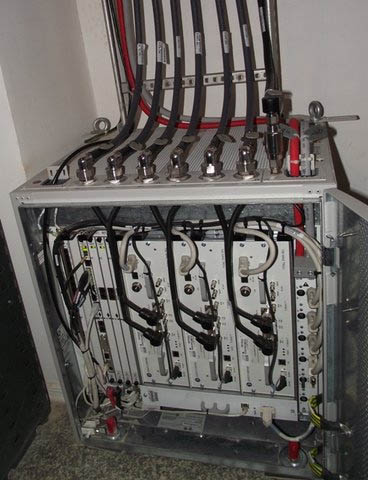
Base station
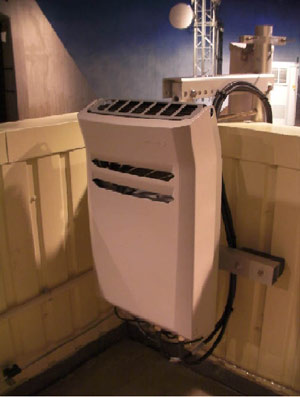
Base station
And since the BS of different standards are more similar than different, manufacturers quickly guessed to do everything “in one bottle”. The solution is called SingleRAN. One BS for 3 standards: GSM, 3G and LTE. It is very convenient for the operator in terms of saving space and power on the site, reducing installation time and so on. We have already started to buy and install these on the network. So, as soon as, so immediately ...
LTE does not need any special antennas. Normal panel antennas with cross-polarization are quite suitable. They, for example, are used in GSM networks and in 3G. However, if in GSM and 3G two polarizations are usually used for reception and only one for transmission (2Rx / 1Tx scheme), then in LTE both polarizations are fully activated, both for reception and for transmission (2Rx / 2Tx scheme). This is necessary for the implementation of MIMO2x2 technology. At the first stage of LTE implementation, this will be enough. Further sector bandwidth can be increased by adding another cross-floor antenna. The result is a 4Rx / 4Tx and MIMO4x4 circuit. The main thing is to spread the antennas in space at a sufficient distance (about 10 wavelengths).
What else of the "iron"? The access network controller (as BSC in GSM, or RNC in 3G), as a separate physical and logical node in the LTE network, no, the BSs are connected directly to the Core nodes, and only over IP. Core is used only batch. Called EPC (evolved Packet Core). Fortunately, a relatively new regular Packet Core is being converted to EPC by upgrading software. The MME functional (mobility management node in LTE) can be rolled onto the SGSN used for GPRS / 3G, and the PGW / SGW should be able to handle the GGSN. I will not say that all SGSN / GGSNs of Beeline are HW-ready for LTE, but we are confidently moving in this direction.
Plus SAE-HSS (subscriber profile storage), which also rises on the existing ngHLR HW platform. That's the whole LTE network.

LTE architecture
About transport
GE ports on BS. This, as Winnie-the-Pooh used to say, was no accident: you surely understand what a backbone should be with such a backhaul! If any dear readers have a few free billion dollars, I can tell you how to spend it with benefit ...
About frequencies
Unlike other mobile standards, LTE is not tied to any particular frequency range. This is his strength. Developers (3GPP) have identified more than 30 bands for which manufacturers can produce standard LTE radio equipment. This includes both the frequencies used now under other standards (for example, 900, 1800 (GSM), 2100 (UMTS), 2500 (WiMAX), and “new”, for example 700-800 MHz (the so-called “digital dividend”). It is clear that not all of the possible ranges will find wide distribution in the world. Most likely, it will “survive” no more than 4-5 ranges. A larger number is very difficult to implement in one subscriber device, and this is already a problem for ensuring global roaming. ask which ranges to bet on, my preferences are as follows:
- 800 MHz (3GPP band 20) - allocated or planned for LTE in almost all European countries, including Russia; advantageous in terms of the cost of providing continuous coverage; equipment is produced by all leading manufacturers;
- 2.5 GHz (3GPP band 7) - allocated or planned for LTE in almost all European and Asian countries, including Russia; advantageous when providing capacity in hot spots; The equipment is produced by all leading manufacturers.
- 1800 MHz (3GPP band 3) - will be released as the number of GSM-only phones decreases and 3G coverage expands (so that there is where to transfer voice); good in terms of ensuring a network balance between capacity and coverage; GSM operators will be able to save by reusing the infrastructure of the access network (transceivers, antennas); equipment is produced by almost all leading manufacturers
In general, choosing the right range for the development of LTE is not an easy task. In the lower ranges, where everything is fine with coverage, the problem is to find a band sufficient for a full LTE width. In the upper ones it is usually good with a frequency resource, but the BS should be installed every 400-500 meters, you will go bankrupt on a solid surface! Probably most LTE networks, like GSM, will be dual-band.
About speed
Maximum data transfer rates are a key indicator of the standard's coolness for end users. And LTE is really cool! You can talk for a long time about the theoretical possibilities of different standards, the prospects for their development, and so on, but the fact that speeds over 100 Mbit / s are available to subscribers in already working LTE networks is a fact. And this is only the beginning of a bright future: I am sure that achieving LTE speeds up to 1 Gbps is a matter of several years. We will see further. Most likely, another breakthrough will be needed, both in radio communication theory and in the production technology of the element base.
Pro coating
The coverage area of one BS in LTE can be completely different. What does it depend primarily on? Right! From the used frequency range. If we compare the extreme options, then the coverage area of one eNodeB operating in the lowest LTE range (700 MHz) is, all other things equal, 5-6 times larger than for a base operating at 2.5 GHz. Under urban conditions, the cell radius can therefore be from several hundred meters to several kilometers. As for the record for the range of the LTE BS, it was installed during the trail of the Greek operator Cosmote on the Huawei equipment earlier this year - at a distance of 102 km from the BS, a transfer rate of 135 Mbps was obtained. Of course, it was direct visibility and one subscriber in a cell. But in terms of the limits of the standard - quite convincingly.
Pro gadgets
LTE-enabled subscriber devices currently available on the market include (by type):

USB modems (in the picture - Huawei E398)
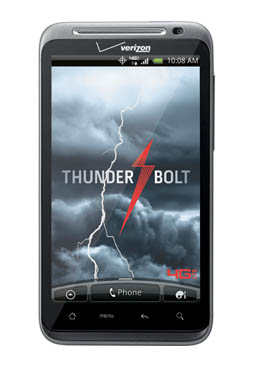
Smartphones (pictured is HTC Thunderbolt, Android OS)

Tablet (in the photo - Samsung Galaxy Tab 10.1, Android OS)
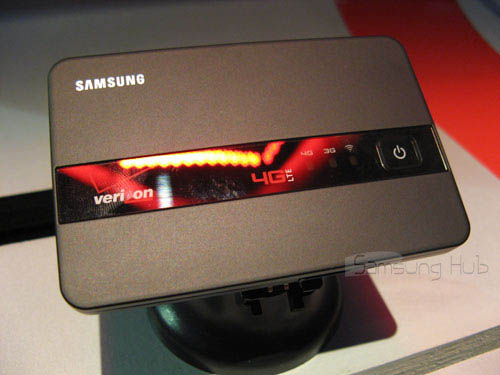
Portable LTE / Wi-Fi Hotspot (pictured is Samsung SCH-LC11)

Laptop (in the picture HP Pavilion DM1-3010NR)
Currently, more than 100 LTE-enabled subscriber devices are available on the market and this number is growing every day. The main players in this market are our old acquaintances: Samsung, LG, HTC, ZTE, Huawei.
About experiences
I wanted to see how LTE works live, for a long time. The first time happened at the beginning of last year in Stockholm. Thanks to colleagues from Ericsson, they called me to look at the world's first commercial LTE network - Telia-Sonera. Honestly, was a little disappointed. The speeds, while riding around the city in a minibus, ranged from 0 to 8 Mbps. In addition, the connection is constantly torn. Colleagues justified by the fact that the network is not yet optimized, the BS is small, the range is high - 2.5 GHz. Everything, of course, is understandable, but I wanted a miracle.
Upon arrival from Sweden, we decided to build a pilot LTE network in one of our countries. The easiest way to agree with the Regulator on the allocation (at the time of the pilot) frequencies under LTE was in Kazakhstan. The frequency range selected the lowest of the available - 700 MHz (more precisely, the band 13, exactly the denominations, on which the American Verizon network builds). By the end of October 2010, in cooperation with Alcatel-Lucent, networks were built in two main cities of Kazakhstan (Astana and Almaty). What happened turned out to be shown to officials, journalists, and the most interested of potential clients. You can read more here .


Pro voice
Do I need voice transmission in LTE? On the one hand, it’s improper to remain a mobile standard that claims to be a global one, without a basic coherent service. On the other hand, it’s difficult to imagine that LTE coverage will appear where there is no GSM or 3G. That is, the subscriber will not remain without a voice.
LTE-Advanced will come sooner or later, additional frequencies will be required. And where can I get them if not from GSM and 3G networks? Then LTE will be left alone with the subscriber, who, as before, will need to talk - which means that a voice in LTE will definitely be a matter of time. Now in the first commercial networks, the function CS Fallback is implemented to provide voice calls. Having received a message about an incoming call on an LTE service channel, the subscriber device switches to GSM or 3G mode and informs the network that it is ready to accept the call. After that, the call is made via GSM / 3G CS Core.
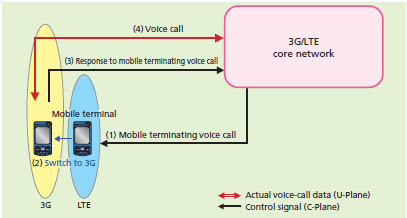
CS Fallback in action
In the future, when moving to an all-IP architecture, voice in mobile networks will remain only in the form of VoIP. Then the question of choosing a radio access network through which voice calls will go will be reduced to capacitive characteristics - the greater the bandwidth of the sector, the more simultaneous calls it can serve.
Source: https://habr.com/ru/post/129694/
All Articles